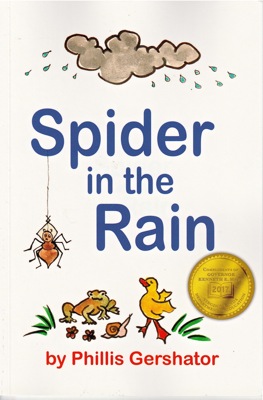|
|
|

|
by Phillis Gershator
Little
Bell Caribbean, 2017
|
* Governor's
Summer Reading Challenge, U.S.
Virgin Islands, 2017
|
From
the book jacket:
|
A small spider happily looks out
from a rooftop gutter,
admiring the fluffy clouds passing
overhead,
but the clouds he sees are RAIN
clouds.
What should a little creature like
him do in the rain?
Iguanas, bats, birds, mongooses,
butterflies, and bees all
give the spider good advice. But
itís too late.
Down comes the rain and washes the
poor spider outĖĖ
down the waterspout and into a
pond.

What will happen to our spider?
Will he survive?
If he does, will he return to his
old ways,
or will he try something new?
|
| A
little about the book: |
Since some of my favorite books are
stories exploring the
natural world, my mother said I
should write a book about animals in
the rain. Together we wrote verses,
but the story didn't take off. Years
went by. Then I thought, This
story needs a hero, but who? I
know! The Eensy Weensy Spider!
So I rewrote the story, using the
pattern of another rhyme, also
featuring a spider: "Little Miss
Muffet." And now I hope Summer
Reading Program participants
will get a good head start on
reading, rhyme, and science with our
little spider and its friends, and
then read five or more other
books this summer, rain or shine!
|
|
Ten
things to do and talk about:
1) Count
the creatures in the rain,
starting with ONE spider and TWO
iguanas. How many ducks? How many
tadpoles plus frogs?
2) Sing "The Eensy Weensy Spider"
and read the Mother
Goose rhyme "Little Miss Muffet." How do they end? Does
this spider story have a
different ending?
3) Can you think of new
endings for other story
songs and
rhymes, like "Humpty
Dumpty" or "Baa, Baa,
Black Sheep"?
4) Find five fantastic fun facts
about each
creature in this book in
non-fiction books and science
sites online.
Starting with Spider, here's
one fantastic
fact: spider's egg cases
contain hundreds of eggs.
This
is a photo of a
spider's egg case (or
"sac"). Each dot is a
baby
spider, right after
hatching. They're
clinging to the
spider web on my
car!
Another
fact: spider silk
is stronger and
lighter and
stretchier than just
about any man made
material.
And
one more: did
you know that
spiders in the
house can be
helpful, if you
don't mind having
a few spider webs
around, because
they trap and
eat
pesty
insects like
mosquitoes,
flies, and
roaches.
5)
Furry animals
can shake rain
water off
their fur.
Birds oil
their feathers
so water
slides off.
Insects canít
fly with wet
wings so they
hide where
it's dry. What
about some
other little
creatures,
such as snails
and turtles
and
earthworms?
What do they
do in the
rain?
6)
Add more
verses to Spider
in the Rain.
What
would other
creatures (big
or small) tell
the spider
to do
when it rains?
7)
Rain
is a source of
fresh water.
Why do plants
and animals
need fresh
water?
8)
Find a
diagram or
chart of the
water cycle.
Here are two
good ones
online:
https://water.usgs.gov/edu/watercycle-kids.html
earthguide.ucsd.edu/earthguide/diagrams/watercycle/
9)
What would our
island look
like if it
never rained?
Draw a before
and after rain
picture.
10) Read other spider stories. Funny picture books
starring
spiders
include Diary of a Spider
by Doreen Cronin and The
Eensy Weensy Spider by
Mary Ann Hoberman. There are lots of great
stories about the most famous
Afro-Caribbean
spider: ANANSI.
My favorite is Anansi the
Spider by Gerald
McDermott. Another famous spider
is Charlotte in the
classic book Charlotte's Web
by E. B. White.
If you have
a favorite spider story, let me
know, and I'll add it to the
list!
|
|
|
|
|